|
Suzuki Swift
Debut: 2005
Maker: Suzuki
Predecessor: Swift (1989)
|
|
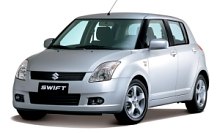 When
Suzuki Swift was born in 1984 (the year I started reading car
magazines), it was just an ordinary Japanese econo car. It caught my
first attention two years later, when the Swift GTi was launched. Local
newspaper advertisement compared it to a red hot chili. Yes, can you
tell me which small car employed a high-tech, 8000 rpm-topping
1.3-litre 16 valves engine that produced 100 horsepower ? At that time,
only a motorcycle maker like Suzuki could do it. In 1989, the second
generation Swift excited me even further by introducing a stylish look,
an independent rear suspension and a roomy interior. It became the
standard of Japanese hot hatch. When
Suzuki Swift was born in 1984 (the year I started reading car
magazines), it was just an ordinary Japanese econo car. It caught my
first attention two years later, when the Swift GTi was launched. Local
newspaper advertisement compared it to a red hot chili. Yes, can you
tell me which small car employed a high-tech, 8000 rpm-topping
1.3-litre 16 valves engine that produced 100 horsepower ? At that time,
only a motorcycle maker like Suzuki could do it. In 1989, the second
generation Swift excited me even further by introducing a stylish look,
an independent rear suspension and a roomy interior. It became the
standard of Japanese hot hatch.
Unfortunately, in the 90s the Japanese government loosened the
regulations on K-cars, causing a boom to K-car market. Suzuki therefore
concentrated all resources into K-car programs, letting the Swift to
get outdated and relied on low price to survive. In year 2000, Swift
was finally renewed, but this time it became merely an enlarged version
of the K-car “Kei”. Suzuki still resisted to join the European trend of
“super mini”.
The market situation changed again in recent years. Toyota Yaris (Vitz)
and Honda Jazz (Fit) opened up the sub-compact market in Japan. On the
other hand, Suzuki's overseas markets have been seriously threatened by
the Korean invasion. It finally realized the Swift must go upmarket.
New Swift
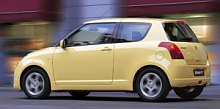 The
third generation Swift was designed with European market in first mind.
This is immediately revealed by its styling, which has strong European
flavour. Suzuki sent its designers to Europe for 6 months to finish the
design. The 1.5-box body incorporates a bold front end, a wide C-pillar
and a strong shoulder line to deliver a perception of solidity. On the
other hand, the curvy bonnet, flared wheelarches and blackened
A-pillars deliver a sporty and aggressive feel unfound in the current
generation mini cars. The
third generation Swift was designed with European market in first mind.
This is immediately revealed by its styling, which has strong European
flavour. Suzuki sent its designers to Europe for 6 months to finish the
design. The 1.5-box body incorporates a bold front end, a wide C-pillar
and a strong shoulder line to deliver a perception of solidity. On the
other hand, the curvy bonnet, flared wheelarches and blackened
A-pillars deliver a sporty and aggressive feel unfound in the current
generation mini cars.
The chassis profile is equally sporty – at 3695 mm long, the Swift is
100-200 mm shorter than other super minis on the market, but its 1690
mm width is about 50 mm wider than the class norm. This allows wide
tracks to benefit handling. The height is 1500 mm, not excessive by
today's standard. Wheelbase is 2380 mm, remarkable considering its
length.
 The chassis continues to employ
MacPherson struts at the front, but now it is mounted on a sub-frame
together with engine and steering rack. Suzuki used to employ
trailing-arm (with 3 links) for rear suspensions. Now the Swift sees a
switch to the more popular torsion-beam axle like other European mini
cars. This not only improves wheel control but also reduces unsprung
weight and frees up more luggage space. Expect the company's next
generation K-cars will also have this change. The chassis continues to employ
MacPherson struts at the front, but now it is mounted on a sub-frame
together with engine and steering rack. Suzuki used to employ
trailing-arm (with 3 links) for rear suspensions. Now the Swift sees a
switch to the more popular torsion-beam axle like other European mini
cars. This not only improves wheel control but also reduces unsprung
weight and frees up more luggage space. Expect the company's next
generation K-cars will also have this change.
The Swift's chassis was tuned on European roads. No wonder it handles
like a well-sorted European hatchback. It feels sure-footed in
cornering, without the excessive body roll that usually associate with
Japanese mini cars. Its electric power steering is quick, precise and
delivers decent feel from the road. Its brakes have good stopping power
and feel. Its gearchange is crisp. Moreover, the Swift is good at
playing
lift-off oversteering - a skill forgotten by many nowadays super minis.
Fun factor is definitely high.
Performance is not so good. The Swift has a choice of two engines: a
short-stroke 1.3-litre 16V (92 hp) and a long-stroke 1.5-litre 16V with
VVT (102 hp). The smaller engine is actually the better, because it is
smoother and more eager to rev. However, with just 84 lbft of torque
available at a relatively high 4400 rpm, tractability is a problem. The
1.5-litre engine should have been the answer, but its torque delivery
is no where as rich as its long stroke and variable valve timing
suggested. Moreover, it sounds coarse at high rev, ruining the
otherwise fine refinement.
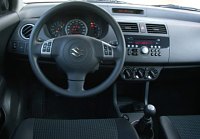 Sitting
behind the steering wheel, you will find the minimalist dashboard
design is pleasing. Although it doesn't employ any high-quality
materials, it looks by no means cheap. The hard plastic used in the
dashboard get fine grained. All parts are solidly fixed and tightly
fitted together. No one else in this class has a steering wheel with
built-in stereo control buttons like this. Nor any rivals have their
audio player integrated smoothly with the dashboard. Suzuki cleverly
uses design to achieve an upmarket feel, saving the need for costly
materials. Sitting
behind the steering wheel, you will find the minimalist dashboard
design is pleasing. Although it doesn't employ any high-quality
materials, it looks by no means cheap. The hard plastic used in the
dashboard get fine grained. All parts are solidly fixed and tightly
fitted together. No one else in this class has a steering wheel with
built-in stereo control buttons like this. Nor any rivals have their
audio player integrated smoothly with the dashboard. Suzuki cleverly
uses design to achieve an upmarket feel, saving the need for costly
materials.
Although the car is shorter than other super minis, its cabin offers
plenty of room for 4 people. However, the cabin layout is very
conventional, without the fashionable sliding rear seats or MPV-like
flexibility that some rivals offer. The boot is also very small, but
you can't have a compact car, a big cabin and a big boot
simultaneously, can you?
In recent years, mini cars go increasingly like MPV. They might be
versatile and flexible, but their added weight and height inevitably
hamper driving fun. Thankfully, Suzuki Swift still sticks to the
traditional hatchback formula. Its handling and ride put smile back on
the driver's face. What a pity it lacks a good engine to match the rest
of the car. If it were given a superb engine like the "red hot chili"
did, it could have been a class winner. |
| The
above report was last updated on 4 May 2005. All
Rights Reserved. |
Swift Sport
|
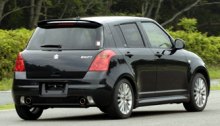 We
know the new Swift is fun to drive, only its engines disappoint.
Naturally, we hope its hot version would get a bigger and better
engine. So, here comes the Swift Sport with its new 1.6-litre engine.
Stroked out from the 1.5-litre and has compression ratio increased to
11.0:1, plus higher valve lift and freer exhaust, the hotter engine
pumps out 125 horsepower at an exciting 6800 rpm and 109 lbft of torque
at 4800 rpm. That's more than the 1.6-class norm - for example, BMW
Mini Cooper can only muster 115 hp, while Citroen C2 VTS 123 hp and
Renault Clio 115 hp. The engine revs cleanly towards 7000 rpm. This
does not come at the expense of low rev tractability, thanks to
variable inlet valve timing. We
know the new Swift is fun to drive, only its engines disappoint.
Naturally, we hope its hot version would get a bigger and better
engine. So, here comes the Swift Sport with its new 1.6-litre engine.
Stroked out from the 1.5-litre and has compression ratio increased to
11.0:1, plus higher valve lift and freer exhaust, the hotter engine
pumps out 125 horsepower at an exciting 6800 rpm and 109 lbft of torque
at 4800 rpm. That's more than the 1.6-class norm - for example, BMW
Mini Cooper can only muster 115 hp, while Citroen C2 VTS 123 hp and
Renault Clio 115 hp. The engine revs cleanly towards 7000 rpm. This
does not come at the expense of low rev tractability, thanks to
variable inlet valve timing.
However, compare with the similarly weighed Renault Sport Clio 182, the
Suzuki engine is too small. 1998 cc vs 1586 cc, 182 hp vs 125 hp. There
is no contest at all. While the hot Clio runs to 60 mph in 6.3 seconds,
the warm Swift takes 8.5 seconds. As for top speed, 139 mph versus 125
mph. A technical knock-out. Sadly, "red hot chili" is no longer that
hot today.
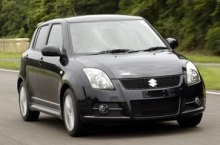 Luckily,
the little engine sounds sporty and the gearshift - quick and short -
is enjoyable. Moreover, the Swift Sport is noticeably cheaper than the
hot Clio, i.e. £11,000 vs £15,000, with the £13,000
Mitsubishi Colt CZT slotting between them. For so little money, you
won't expect firebreathing performance, will you? Luckily,
the little engine sounds sporty and the gearshift - quick and short -
is enjoyable. Moreover, the Swift Sport is noticeably cheaper than the
hot Clio, i.e. £11,000 vs £15,000, with the £13,000
Mitsubishi Colt CZT slotting between them. For so little money, you
won't expect firebreathing performance, will you?
Like the regular Swift, handling is the better aspect than performance.
Unlike most other so-called "hot hatches" of nowadays, the Swift leaves
old school lift-off oversteer for its driver to play. Of course, this
is not as pronounced as the classic Peugeot 205 GTi, but entertaining
enough. What a pity its electric power steering cannot match 205's in
terms of feedback, especially when the front wheels approaching their
limits. This means it does not give its driver as much confidence.
Unsurprisingly, the Sport has stiffer suspensions, bigger wheels, wider
tires and stronger brakes than the bread-and-butter version. The result
is a sporty handling. If you want to buy a hot hatch with very little
money, this is the only choice in the view of keen drivers.
|
| The
above report was last updated on 10 Aug
2005. All Rights Reserved. |
|
|